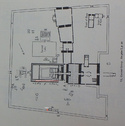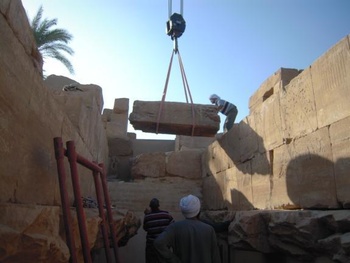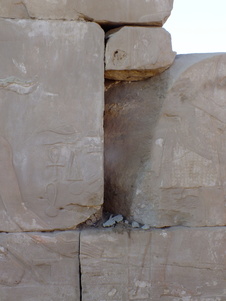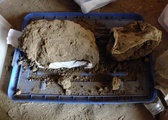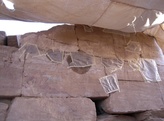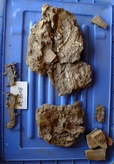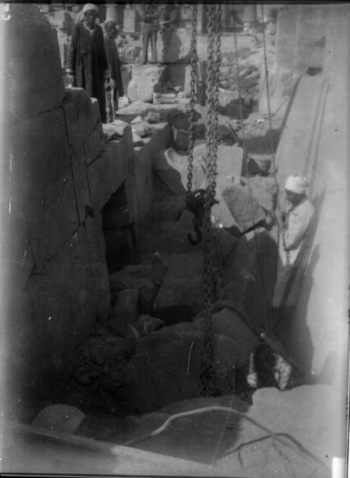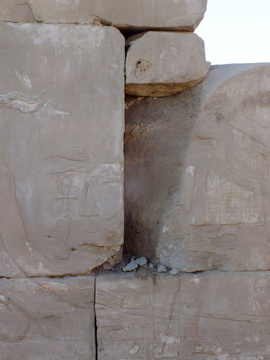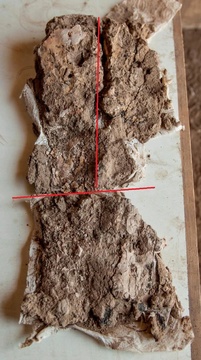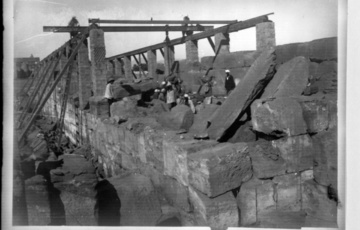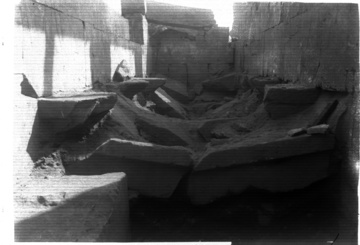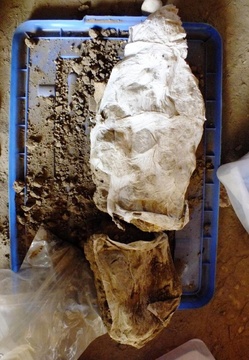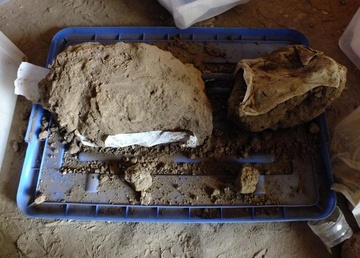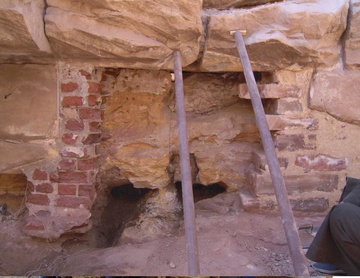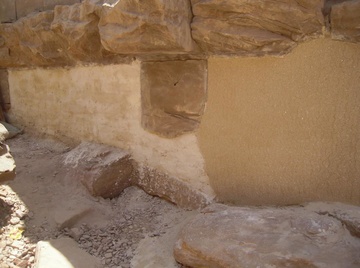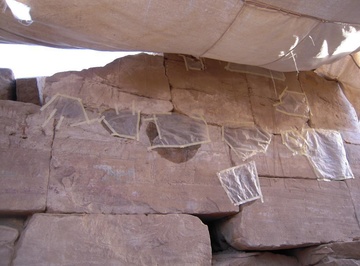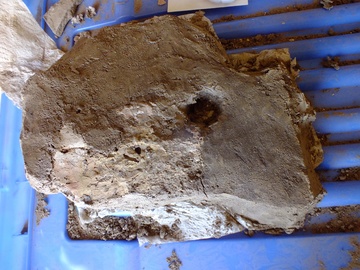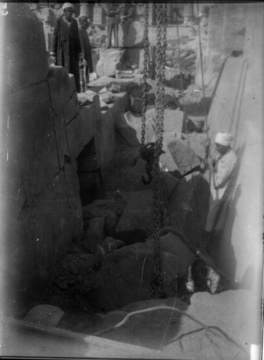As part of this presentation, I would like to show the specificities of an archaeological site as Karnak. So I will present the main questions and difficulties we are facing during the conservation programmes at Karnak.
These questions concern the different scales in size, number, time, and the different materials and places of discovery.
To illustrate my saying, I will choose two examples:
The northern storerooms[1]. They are an architectural complex that runs north of the Middle Kingdom. They were built and decorated in the time of Thutmose III. They consist of seven rectangular rooms accessible through a door. They are partially occupied by upraised floors. The walls located above the upraised floors are decorated with cult scenes. (fig. 6.1) and (fig. 6.2)
A statue of Osiris discovered during the archaeological excavation in Ptah Temple[2] conducted by Guillaume Charloux. It was probably made of wood on which a white coat layer had been laid, in order to allow polychrome decorations and gilding. It was identified through a metal crown. (fig. 6.3)
The first difference between these “objects” is the diversity in their size scales and their numbers of structural elements.
The Northern storerooms are an architectural ensemble with architectural issues: risks of collapse, stability of the building, calculating of the physical forces... (fig. 6.4) and (fig. 6.5)
But they are also singular elements: each storeroom has different characteristics as to its state of conservation: for some there was more polychromy, for others more peeling of the plaster preparation....
To carry out our conservation work, we isolated each scene in each storeroom. They were all examined and each detached fragment was replaced before going over to another scene, in order to prevent the loss of any fragment. (fig. 6.6), (fig. 6.7)
So the Northern storerooms are like a kind of Russian doll with different size scales nested one within the other. The conservator has to adapt to each of them in order to offer a proper treatment and establish homogeneous restoration documentation for all the scales.
The Osiris statue measures 65 cm high. An advanced state of deterioration has caused the loss ofthe core element, dividing the statue into 4 distinct parts. Nevertheless, for the conservator, it is a whole sculpture which must be given back a scientific shape for the Egyptologist. (fig. 6.8)
From these two examples, the conservation issues and constraints (for example setting up scaffoldings, amount of products to be used), the obligations and structural or aesthetic expectations are very different and require specific responses.
The second different is their diversity of interventions in time
The Northern storerooms were built and decorated in the time of Thutmose III. But we found that they were already changed from antiquity: the corridor of access to storerooms has changed since ancient times. Thus a door was created then closed in the storeroom 2.
They were then abandoned and their excavation dates back to the 40s. During this work, the upraised floors were rebuilt and we can assume that the purge and the establishment of the cement and red bricks foundations also date back to this period. Further procedures were performed, essentially the release of scattered blocks stored inside the Northern storerooms.[3] (fig. 6.9) and (fig.6.10)
Eventually, in 1997, a last intervention was conducted in storerooms 6 and 7. It concerned only the polychromy that have been cleaned by sandblasting and consolidated with acrylic resin, Paraloid B72 at 2.5% in P-Xylene.[4]
So when the intervention tests began, one has to cope with the heterogeneity of previous interventions. Decide which restorations should be deleted and which could be conserved. And find a new consolidating material for all storerooms, compatible with those used on former interventions in storerooms 6 and 7. It was therefore necessary to compromise and prioritize the cultural values[5] of the storeroom in order to determine our goals.
- Scientific value to allow Egyptologists to accessto information.
- Ancient value to keep the original materials as much as possible.
- Historical value to trace the evolutionof the building.
- Aesthetic and educational value to allow the reopening of this part of the site to the public.
- And eventually utilitarian value to avoid these spaces to be used again as toilets like before our intervention.
- The statue of Osiris was discovered in December 2014 by Guillaume Charlouxina pit at the back of the temple of Ptah. This favissa[6] gathered a set of objects.[7]
The time scale was not then to adapt to previous interventions, but to establish a respectful restoration treatment for an object passing from an excavation to a discover context. So I decided to keep a ball of earth and consolidate with surface facings glued with acrylic resin, Acril 33-3% in water. A long drying time has been then recommended before starting the cleaning process and consolidation. (fig. 6.11) and (fig. 6.12)
After these examples about time-scale diversity and questions preceding conservation treatment, let’s go to the diversity of materials available in Karnak
The original materials of the Northern storerooms are: sandstone blocks, coating of white plaster preparation, polychromy combining a mixture of arabic gum and pigments, wooden dove-tails.
Materials in addition for restoration are: cement and red bricks masonry, metallic beams and a synthetic consolidating material.
The treatment finally applied in the storeroms was a systematic removal of the cement and red bricks masonry, and a purging of the original sandstone blocks in foundations, because the salts imprisoned by the cement had completely disaggregated them. They have been replaced by a lime and stone masonry. (fig. 6.13) and (fig. 6.14)
 fig. 6.13 Removing the cement and red bricks masonry and replacing by a lime and stone masonry [Bildquelle: © CNRS-CFEETK/C. Bourse]
fig. 6.13 Removing the cement and red bricks masonry and replacing by a lime and stone masonry [Bildquelle: © CNRS-CFEETK/C. Bourse] The upper blocks engraved and painted were of course preserved. Their fragmentation was stopped by treatment with ethyl silicate, Whacker OH100 cut with White spirit 50/50. This shows that the same material can be given different treatments according to its location and utility in the building. (fig. 6.15)
The Osiris statue is made of earth, potsherds, vegetable fibers, a white coating preparation, painting, gilding and a metal crown.
The wooden structure had completely disappeared and was replaced by earth. It has been preserved as only remaining relieves of the sculpture.
When it was discovered and because of its very advanced degradation, it was decided to apply partially the treatments usually employed to remove mosaics in an archaeological context. That means:
- A surface consolidation with facing and acrylic resin, Acril 33 at 3% in water.
- A ball of earth to set the back and a treatment of the back after drying in order to enable better stability and handling of the statue.
- And only at the end, remove of the facings and cleaning with water and enzymes and consolidation of the surface. (fig. 6.16), (fig. 6.17)
So it’s obvious that in our context the diversity of materials requires a plurality of skills (work on different materials) and a constant research to get information on treatments applied to other specialties (here mosaic) to be transposed.
Finally the last diversity concerns the discovery and the conservation of materials:
The Northern storerooms are an architectural complex that was partially reassembled, which means that the exterior walls never collapsed. They were just stuck in the sand. It is attested by the dove-tails holding the upper blocks together. However, as I explained before, only the false ceilings had been reassembled.
Therefore, except the foundations whose alteration was accelerated by previous conservation interventions, the magazines are rather in "good" condition. They certainly needed conservation interventions but their physical integrity was not on the point of ruin. (fig. 6.18)
While the Osirian statue was on the edge of destruction, which required immediate action. (fig. 6.19)
In Karnak, the progress of the deterioration of the objects, blocks and sculptures ... depends on the moment, condition and environment of their burial and discovery. And also the places where they were stored afterwards: on the ground or on benches, under the sun or in the shade ... So blocks that belonged to the same original building can be found in very different states of alterations.
Through this presentation and examples, I showed the main and various questions we are facing at Karnak. As well as the responses we try to provide for each case.
Finally, I want to specify that large scale projects are made possible because the CFEETK is a permanent mission. The various specialties gathered here contribute to the scientific publication of results, with the realization of facsimiles and pictures in order to allow Egyptologists to access readable information.

